contributor
The Big Black Cockroach: Your Comprehensive Identification and Control Guide
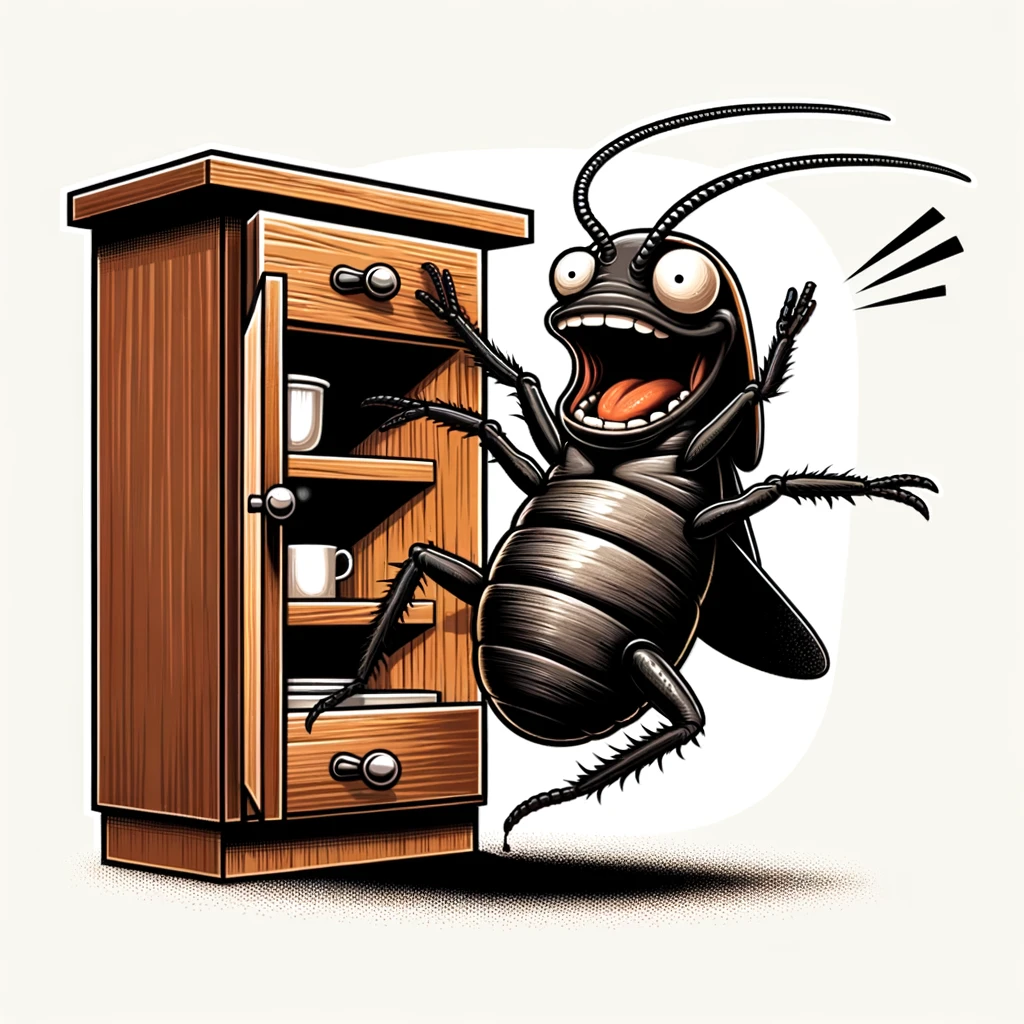 Encountering a big black cockroach can be a startling experience due to their size and dark appearance. These cockroaches are not just a common pest problem but can also pose health risks by spreading diseases. This guide is dedicated to helping you identify them, understand their habitats and behaviors, and implement effective control strategies.
Encountering a big black cockroach can be a startling experience due to their size and dark appearance. These cockroaches are not just a common pest problem but can also pose health risks by spreading diseases. This guide is dedicated to helping you identify them, understand their habitats and behaviors, and implement effective control strategies.
Identifying the Big Black Cockroach
Physical Characteristics
Big black cockroaches, often referred to as the Oriental Cockroach (Blatta orientalis), are distinguishable by their shiny black to dark brown exoskeleton. Adults can grow up to 1 inch in length, making them one of the larger species that invade homes.
Distinguishing Features
- Size: Up to 1 inch for adults.
- Color: Shiny black to dark brown.
- Wings: Males have wings that cover about ¾ of their body, while females have shorter wings and cannot fly.
Common Habitats and Behaviors
Indoors
Big black cockroaches are commonly found in damp and dark areas such as basements, crawl spaces, and around drains. They are nocturnal and prefer to stay hidden during the day.
Outdoors
Outside, they thrive in areas with high moisture content, such as under mulch, in trash, and around decaying organic matter. They enter homes in search of food and water.
Effective Control Strategies for Large Cockroaches
Sanitation and Exclusion
- Eliminate Food and Water Sources: Keep your home clean, fix leaky faucets, and ensure that food is stored in sealed containers.
- Seal Entry Points: Inspect and seal cracks and crevices around doors, windows, and utility pipes to prevent entry.
Chemical Treatments
- Bait Stations: Use bait stations strategically placed in areas of high activity to control the population.
- Insecticides: Professional-grade insecticides can be effective when applied in targeted areas. Always follow the manufacturer’s instructions or consider hiring a pest control professional.
Natural and Non-Chemical Methods
- Diatomaceous Earth: A natural powder that can be effective in controlling cockroaches by damaging their exoskeleton.
- Boric Acid: When used correctly, boric acid can be an effective cockroach killer. However, it must be applied in areas away from human and pet activity.
Conclusion
The big black cockroach is a formidable pest, but with the right knowledge and tools, you can effectively manage and control their presence in your home. Identification, understanding their behavior, and applying targeted control strategies are key to keeping your environment healthy and cockroach-free.
Do Roaches Bite? Uncovering the Truth and Prevention Strategies
 A common question that concerns many homeowners is, “Do roaches bite?” While the thought of cockroaches may already evoke discomfort, the idea of them biting humans adds an extra layer of concern. This post aims to debunk myths surrounding cockroach bites, outline how to identify and treat them, and share effective strategies to prevent cockroach bites, focusing on the keyword ‘do roaches bite’.
A common question that concerns many homeowners is, “Do roaches bite?” While the thought of cockroaches may already evoke discomfort, the idea of them biting humans adds an extra layer of concern. This post aims to debunk myths surrounding cockroach bites, outline how to identify and treat them, and share effective strategies to prevent cockroach bites, focusing on the keyword ‘do roaches bite’.
Debunking Myths: Do Cockroaches Bite?
Contrary to popular belief, cockroaches are not known to frequently bite humans. These pests are omnivores that prefer decaying organic matter, but in extreme cases where their populations are large and food is scarce, cockroaches may bite humans. Such bites are rare and usually not the primary concern when dealing with cockroach infestations.
When and Why Do Cockroaches Bite?
- Scarcity of Food: In overcrowded conditions with limited food sources, cockroaches might resort to biting humans.
- During the Night: Most cockroach species are nocturnal. If bites occur, they are more likely during the night, especially on exposed areas of skin.
Identifying and Treating Cockroach Bites
Cockroach bites are uncommon, but it’s important to recognize them and understand how to treat them effectively.
Identification
- Appearance: Cockroach bites may appear as small, red bumps, similar to mosquito bites. They can become swollen and cause irritation.
- Location: Bites are often on the hands, feet, face, or other exposed areas during sleep.
Treatment
- Clean the Area: Wash the bite with soap and water to prevent infection.
- Reduce Swelling: Apply a cold compress to reduce swelling and alleviate discomfort.
- Seek Medical Attention: If the bite appears infected or symptoms worsen, consult a healthcare provider.
Strategies to Prevent Cockroach Bites
Preventing cockroach bites largely involves measures to control and eliminate cockroach populations in your home.
Maintain Cleanliness
- Eliminate Food Sources: Store food in sealed containers and dispose of garbage regularly.
- Reduce Clutter: Clutter provides hiding places for cockroaches. Keeping your home tidy can reduce their hiding spots.
Seal Entry Points
- Inspect and Seal: Check for cracks, crevices, and entry points around doors, windows, and plumbing. Seal them to prevent cockroach entry.
Use Pest Control Methods
- Baits and Traps: These can help reduce cockroach populations.
- Professional Pest Control: For severe infestations, professional extermination may be necessary.
Conclusion
While the question “Do roaches bite?” can cause unease, it’s reassuring to know that cockroach bites are rare and largely preventable. By understanding the conditions under which bites may occur and implementing effective prevention strategies, you can minimize the risk and keep your home safe from these pests.
Hissing Cockroaches: Masters of Sound Among the Roach Kingdom
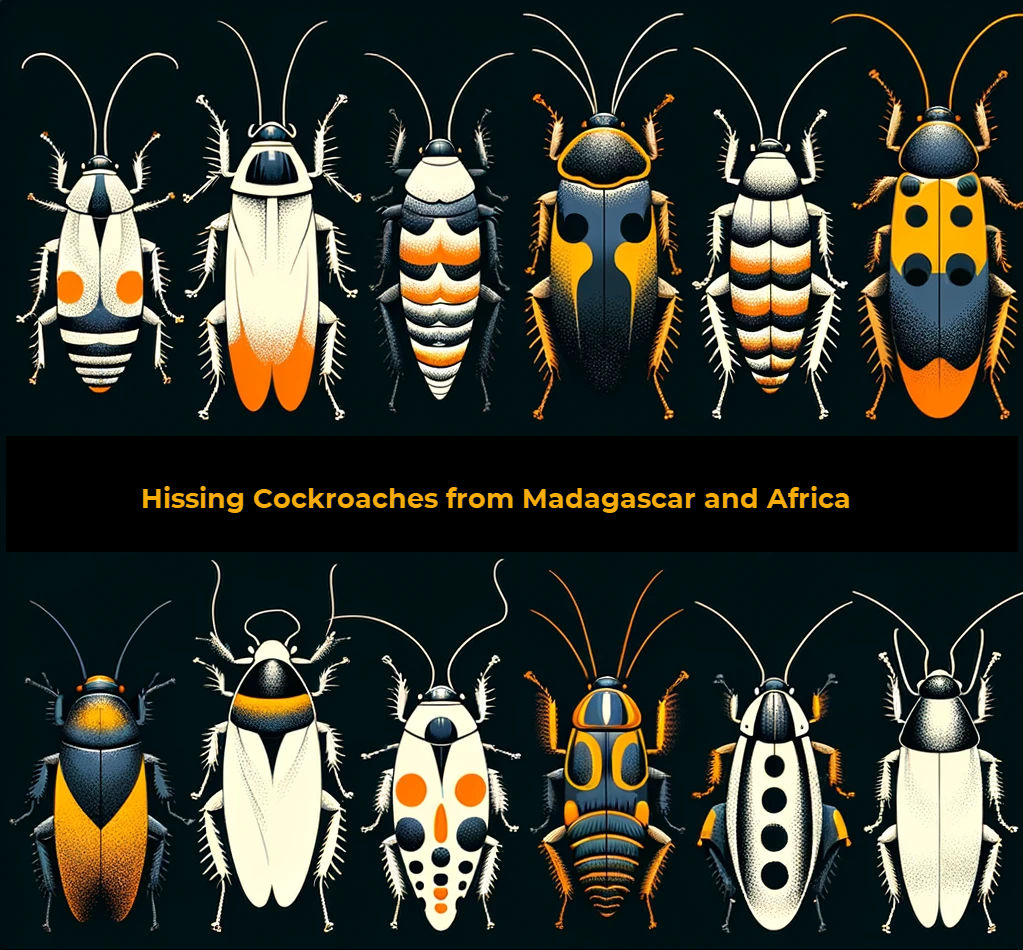 Hissing cockroaches, with the Madagascar Hissing Cockroach (Gromphadorhina portentosa) at the forefront, represent some of the most fascinating members of the cockroach world. Renowned for their distinctive hissing sound, these insects offer a glimpse into the diverse behaviors and characteristics that cockroaches can exhibit. This post explores the world of hissing cockroaches, their unique traits, and the intriguing possibility of keeping them as pets.
Hissing cockroaches, with the Madagascar Hissing Cockroach (Gromphadorhina portentosa) at the forefront, represent some of the most fascinating members of the cockroach world. Renowned for their distinctive hissing sound, these insects offer a glimpse into the diverse behaviors and characteristics that cockroaches can exhibit. This post explores the world of hissing cockroaches, their unique traits, and the intriguing possibility of keeping them as pets.
The Madagascar Hissing Cockroach: A Closer Look
Unique Behaviors and Characteristics
The Madagascar Hissing Cockroach stands out due to its size, reaching up to 3 inches in length, and its lack of wings, unlike many other cockroach species. What truly sets it apart, however, is its ability to produce a hissing sound by expelling air through its spiracles. This behavior serves multiple purposes, including communication, mating, and deterring predators.
Habitat and Lifestyle
Native to the island of Madagascar, these cockroaches thrive in the forest floor’s decaying matter. Their diet primarily consists of fruit and vegetable material, making them detritivores that play a crucial role in their ecosystem.
Beyond Madagascar: Other Hissing Cockroaches
While the Madagascar species is the most well-known, several other cockroaches also possess the ability to hiss, each with its own set of behaviors and adaptations:
- Gromphadorhina oblongonota (Wide-Horned Hissing Cockroach): Notable for its larger size and more pronounced “horns” compared to G. portentosa.
- Elliptorhina javanica (Halloween Hissing Cockroach): Features a striking coloration that makes it a favorite among enthusiasts.
- Aeluropoda insignis (Insignis Hissing Cockroach): Known for its quieter hiss and smoother body texture.
Keeping Hissing Cockroaches as Pets
Hissing cockroaches have become popular pets due to their docile nature and minimal care requirements. Here are some tips for those considering hissing cockroaches as pets:
- Habitat: A secure enclosure with ample space for climbing and hiding. Coconut fiber or peat moss can be used as substrate.
- Diet: A varied diet of fruits, vegetables, and occasional protein sources like dog food ensures proper nutrition.
- Environment: Maintain a temperature of 75-80°F and moderate humidity to mimic their natural habitat.
The African Hissing Cockroach: A Distinct Member of the Hissing Family
While the Madagascar Hissing Cockroach might be the most renowned for its vocal abilities, the African Hissing Cockroach presents its own set of intriguing characteristics that differentiate it from its Madagascan counterpart. Although not as commonly known, this species shares the hissing trait but diverges in habitat, appearance, and behavior.
Unique Traits and Lifestyle
The African Hissing Cockroach, primarily found in regions across the African continent, thrives in a variety of environments, from arid landscapes to lush forests. This adaptability speaks to the cockroach’s resilience and its role in various ecosystems as a decomposer.
- Appearance: It tends to be slightly smaller than the Madagascar species and often exhibits a darker, more uniform coloration that helps it blend into its surroundings.
- Behavior: This species is known for its more aggressive use of hissing, employing it not just for communication or mating rituals but also more frequently as a defense mechanism against predators.
Ecological Impact
The African Hissing Cockroach plays a vital role in its ecosystem, much like its Madagascan counterpart. By breaking down decaying organic matter, it contributes to nutrient cycling and supports the health of the soil and forest floor.
As Pets
While less common in the pet trade than the Madagascar Hissing Cockroach, the African species can also be kept as pets by enthusiasts interested in its unique characteristics and behavior. The care requirements are similar, focusing on replicating their natural environment to ensure their health and well-being.
Expanding Our Understanding
Adding the African Hissing Cockroach to our discussion not only broadens our appreciation for the diversity within the cockroach family but also highlights the ecological significance of these often-misunderstood creatures. Whether in the wilds of Africa or the forests of Madagascar, hissing cockroaches continue to fascinate and educate us on the complexity of nature.
| Species | Characteristics | Habitat |
|---|---|---|
| Madagascar Hissing Cockroach (Gromphadorhina portentosa) | Large size, lacks wings, produces hissing sound by expelling air through spiracles. | Forests of Madagascar, decaying matter on the forest floor. |
| Wide-Horned Hissing Cockroach (Gromphadorhina oblongonota) | Larger size, pronounced ‘horns’, similar hissing capabilities. | Similar habitats to G. portentosa, with a preference for more secluded areas. |
| Halloween Hissing Cockroach (Elliptorhina javanica) | Striking coloration, popular among enthusiasts for its appearance. | Tropical environments, with a preference for humid and warm conditions. |
| Insignis Hissing Cockroach (Aeluropoda insignis) | Quieter hiss, smoother body texture, less common in the pet trade. | Various habitats across Madagascar, adaptable to different environmental conditions. |
| African Hissing Cockroach | Slightly smaller, darker coloration, uses hissing more aggressively as a defense mechanism. | Various regions across the African continent, from arid landscapes to lush forests. |
Conclusion
Hissing cockroaches, particularly the Madagascar Hissing Cockroach, offer a unique window into the complexity and diversity of cockroach species. Whether admired for their ecological role, studied for their fascinating behaviors, or cared for as pets, these creatures challenge the conventional perception of cockroaches and reveal the beauty of biodiversity.
Do Cockroaches Sleep? Unraveling the Mysteries of Cockroach Behavior
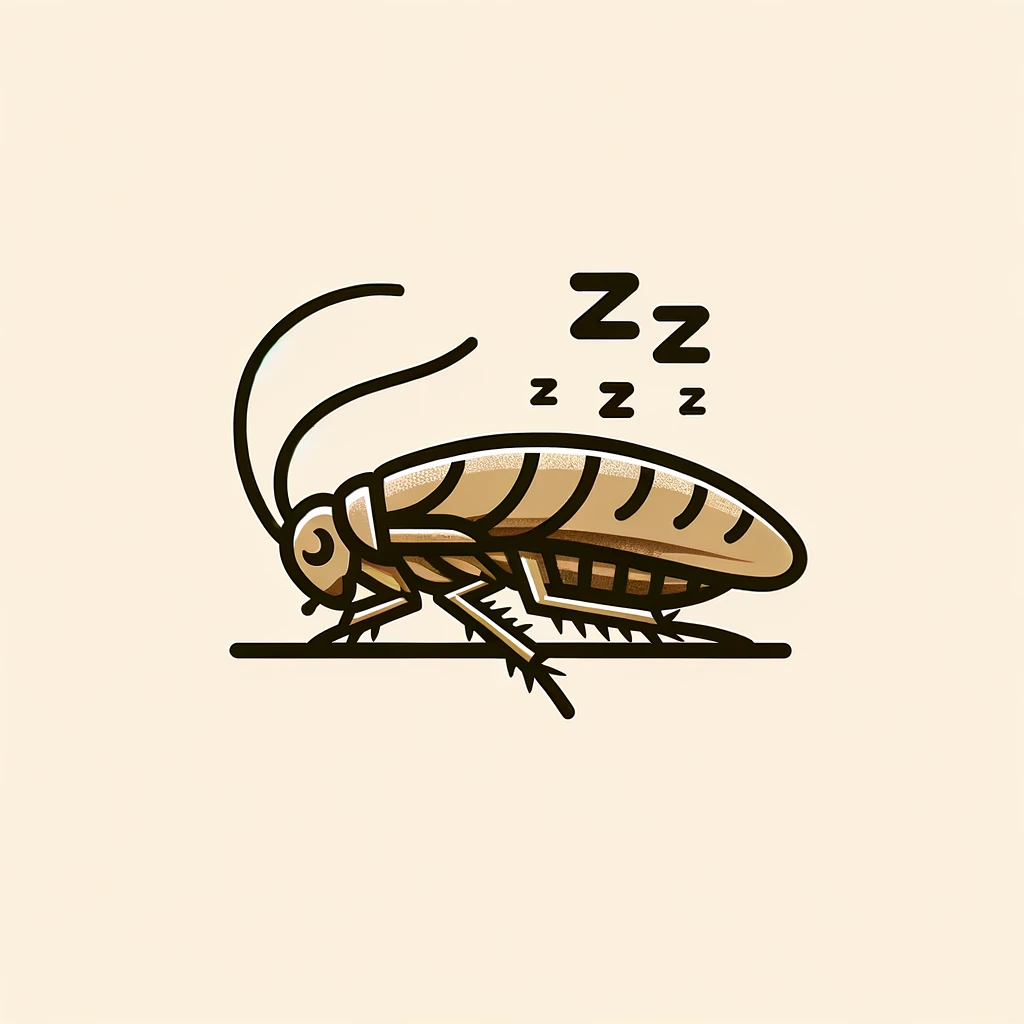 Cockroaches are among the most resilient and adaptable creatures on Earth, thriving in various environments worldwide. But amidst their notorious reputation as hardy survivors, one question often arises: Do cockroaches sleep? This post delves into the fascinating world of cockroach behavior, exploring their sleep patterns, activity cycles, and how light influences their movements.
Cockroaches are among the most resilient and adaptable creatures on Earth, thriving in various environments worldwide. But amidst their notorious reputation as hardy survivors, one question often arises: Do cockroaches sleep? This post delves into the fascinating world of cockroach behavior, exploring their sleep patterns, activity cycles, and how light influences their movements.
Uncovering Cockroach Behavior: Do They Sleep?
The Concept of Sleep in Insects
While cockroaches do not sleep in the same way humans do, research suggests they experience rest periods that could be analogous to sleep. These periods of inactivity are crucial for their survival, offering time for recovery and energy conservation.
Identifying Rest Periods in Cockroaches
Observations of cockroach behavior have shown that they exhibit periods of decreased activity, during which their response to external stimuli is significantly lowered. These rest periods typically occur during the day, as cockroaches are primarily nocturnal creatures.
Understanding Cockroach Activity Cycles
Cockroaches are known for their nocturnal lifestyle, being most active at night when they search for food and mate. This pattern of activity is governed by an internal biological clock, or circadian rhythm, which dictates their periods of rest and activity throughout the 24-hour cycle.
Do Cockroaches Sleep? The Role of Circadian Rhythms
Cockroaches, like many other organisms, possess an internal mechanism that aligns their behavior with the day-night cycle. This circadian rhythm ensures that they remain inactive during the day, reducing their chances of encountering predators.
The Impact of Light on Cockroach Activity
Light plays a crucial role in determining cockroach behavior, particularly their activity levels and rest periods.
Light as a Behavioral Modifier
Exposure to light can disrupt the cockroach’s circadian rhythm, affecting their activity patterns. Sudden illumination, for example, can trigger an escape response, as cockroaches prefer to operate under the cover of darkness.
Adapting to Light Conditions
In environments with artificial lighting, cockroaches may adjust their activity cycles to remain hidden during periods of light exposure. This adaptability allows them to coexist with humans, often going unnoticed.
Conclusion
So back to the original question, do cockroaches sleep? While the notion of sleep in cockroaches differs from human sleep, these creatures do experience rest periods governed by circadian rhythms and influenced by environmental factors like light. Understanding the behavior and activity cycles of cockroaches not only sheds light on their survival strategies but also informs effective pest control measures by highlighting the importance of reducing harborage sites and food sources, especially during their active hours.
Cockroach Life Cycle: Insights for Effective Pest Control
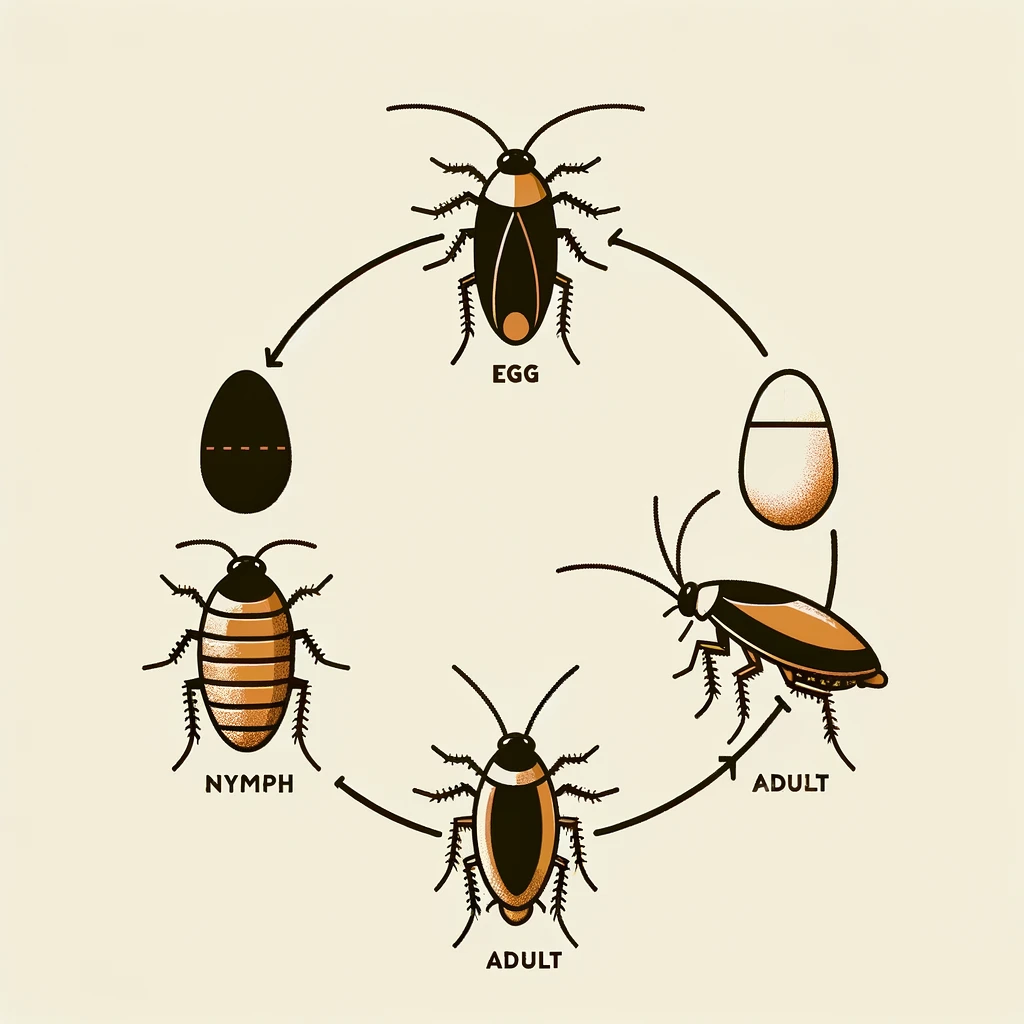 The cockroach life cycle is a fascinating journey from egg to adult, shedding light on the resilience and adaptability of these common household pests. Understanding the cockroach life cycle is not only intriguing from a biological standpoint but also crucial for devising effective pest control strategies. This guide delves deep into each phase of the cockroach life cycle and its implications for managing infestations.
The cockroach life cycle is a fascinating journey from egg to adult, shedding light on the resilience and adaptability of these common household pests. Understanding the cockroach life cycle is not only intriguing from a biological standpoint but also crucial for devising effective pest control strategies. This guide delves deep into each phase of the cockroach life cycle and its implications for managing infestations.
Detailed Overview of the Cockroach Life Cycle
Egg Phase
- Ootheca Formation: The cockroach life cycle commences with the female producing an egg case, known as an ootheca. This protective casing houses multiple eggs, safeguarding the future generation.
- Incubation Period: The duration of the incubation varies across species, with eggs hatching into nymphs after several weeks or months.
Nymph Phase
- Growth and Development: Upon hatching, nymphs resemble miniature versions of adult cockroaches but lack wings. These juveniles undergo several molts, shedding their exoskeletons to grow larger.
- Transition to Adulthood: This phase is crucial with nymphs progressively developing into winged adults capable of reproduction.
Adult Phase
- Reproductive Maturity: Adult cockroaches have fully formed wings and are active breeders, contributing to the rapid expansion of their population.
- Life Span: The lifespan of adult cockroaches varies but can extend for several months, during which they continually reproduce, exacerbating infestation issues.
Stages of the Cockroach Life Cycle and Pest Control
Each stage in the cockroach life cycle offers unique challenges and opportunities for pest control:
- Targeting the Egg Phase: Identifying and eliminating oothecae can significantly impact population control.
- Addressing the Nymph Phase: Since nymphs are more visible and active, strategies that target juvenile cockroaches can curb growth.
- Controlling the Adult Phase: Adult cockroaches are the primary focus of most pest control efforts due to their reproductive capabilities and visibility.
Leveraging Knowledge of the Cockroach Life Cycle for Pest Management
Effective pest management hinges on a comprehensive understanding of cockroach metamorphosis. By targeting interventions at different lifecycle stages, homeowners and pest control professionals can implement more effective and sustainable control measures:
- Sanitation: Eliminating food, water, and shelter sources disrupts the cockroach life cycle, deterring reproduction and survival.
- Exclusion Techniques: Preventing entry by sealing off access points tackles the cockroach life cycle by limiting colonization opportunities.
- Chemical and Biological Controls: Strategically applying insecticides and utilizing natural predators can target specific stages of the cockroach life cycle for more effective infestation management.
Conclusion
A thorough understanding of the cockroach life cycle is indispensable for anyone grappling with cockroach infestations. By appreciating the nuances of each lifecycle stage, effective and targeted pest control strategies can be developed, reducing the impact of these persistent pests on our living spaces.
Oriental Cockroaches: Identification, Infestation, and Control
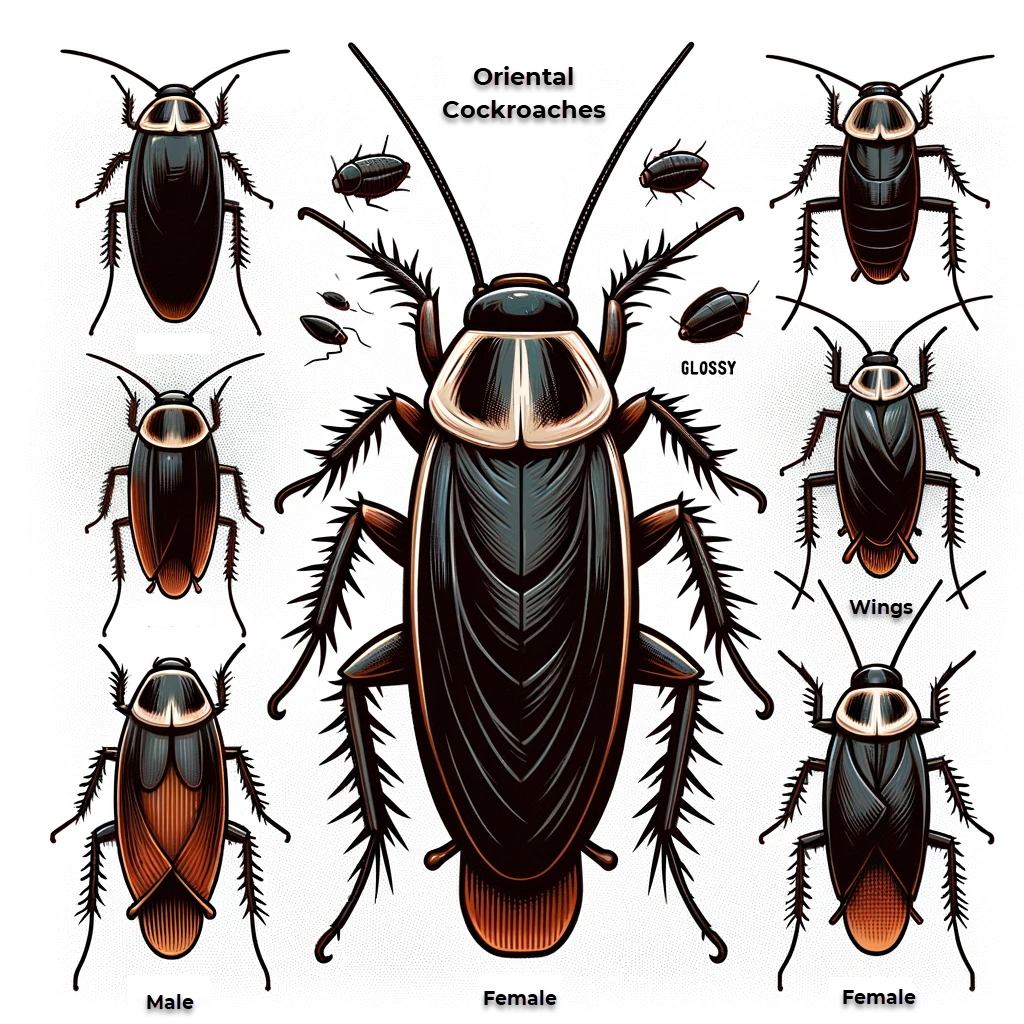 Oriental cockroaches, often referred to as water bugs, are a common pest found in damp and dark areas of homes and buildings. Understanding how to identify these pests, recognize the signs of an infestation, and effectively control and prevent them is essential for maintaining a healthy and comfortable living environment. This guide provides comprehensive information on Oriental cockroaches, including identification tips, insights into their behavior, and best practices for control and prevention.
Oriental cockroaches, often referred to as water bugs, are a common pest found in damp and dark areas of homes and buildings. Understanding how to identify these pests, recognize the signs of an infestation, and effectively control and prevent them is essential for maintaining a healthy and comfortable living environment. This guide provides comprehensive information on Oriental cockroaches, including identification tips, insights into their behavior, and best practices for control and prevention.
Identifying Oriental Cockroaches
Physical Characteristics
- Color: Oriental cockroaches are dark brown to almost black.
- Size: Females can grow to about 1.25 inches, while males are slightly smaller.
- Appearance: Unlike some cockroach species, Oriental cockroaches have a glossy body and may appear smoother. Males have wings that cover about half of their abdomen, while females have very short wings and cannot fly.
Habitats and Behavior
Oriental cockroaches prefer cooler, damp environments. Commonly found in basements, crawl spaces, and near drains or leaky pipes, they can also venture indoors during extreme weather conditions in search of food and moisture.
Understanding Oriental Cockroach Infestations
Signs of an Infestation
- Sightings: Seeing the cockroaches, especially in areas like kitchens, bathrooms, and basements, can indicate an infestation.
- Odor: A musty smell can develop in areas where an infestation is present.
- Droppings: Look for small, pepper-like droppings in kitchen cabinets, along baseboards, or near food sources.
Best Practices for Control and Prevention
Sanitation and Maintenance
- Eliminate Food Sources: Keep your kitchen clean, store food in sealed containers, and dispose of garbage regularly.
- Reduce Moisture: Fix leaky faucets and pipes, use dehumidifiers in damp areas, and ensure good ventilation throughout your home.
- Seal Entry Points: Inspect your home for cracks, holes, and other openings, especially near ground level, and seal them to prevent entry.
Chemical and Natural Controls
- Baits and Insecticides: Use baits and insecticides specifically designed for cockroach control, placing them near suspected activity areas. Always follow the product’s safety instructions.
- Natural Repellents: Diatomaceous earth and boric acid can be effective natural treatments when used in areas where cockroaches travel.
Professional Pest Control
For severe infestations, professional pest control services may be necessary. Experts can offer customized solutions that include thorough inspections, treatments, and follow-up visits to ensure the infestation is fully resolved.
Oriental Cockroaches Conclusion
Oriental cockroaches pose unique challenges due to their preference for damp environments and their resilience. By following the identification and control measures outlined in this guide, you can protect your home from these unwelcome guests. Remember, consistency in prevention efforts and swift action at the first sign of an infestation are key to keeping Oriental cockroaches at bay.
What are Sewer Roaches? How to Get Rid of Them
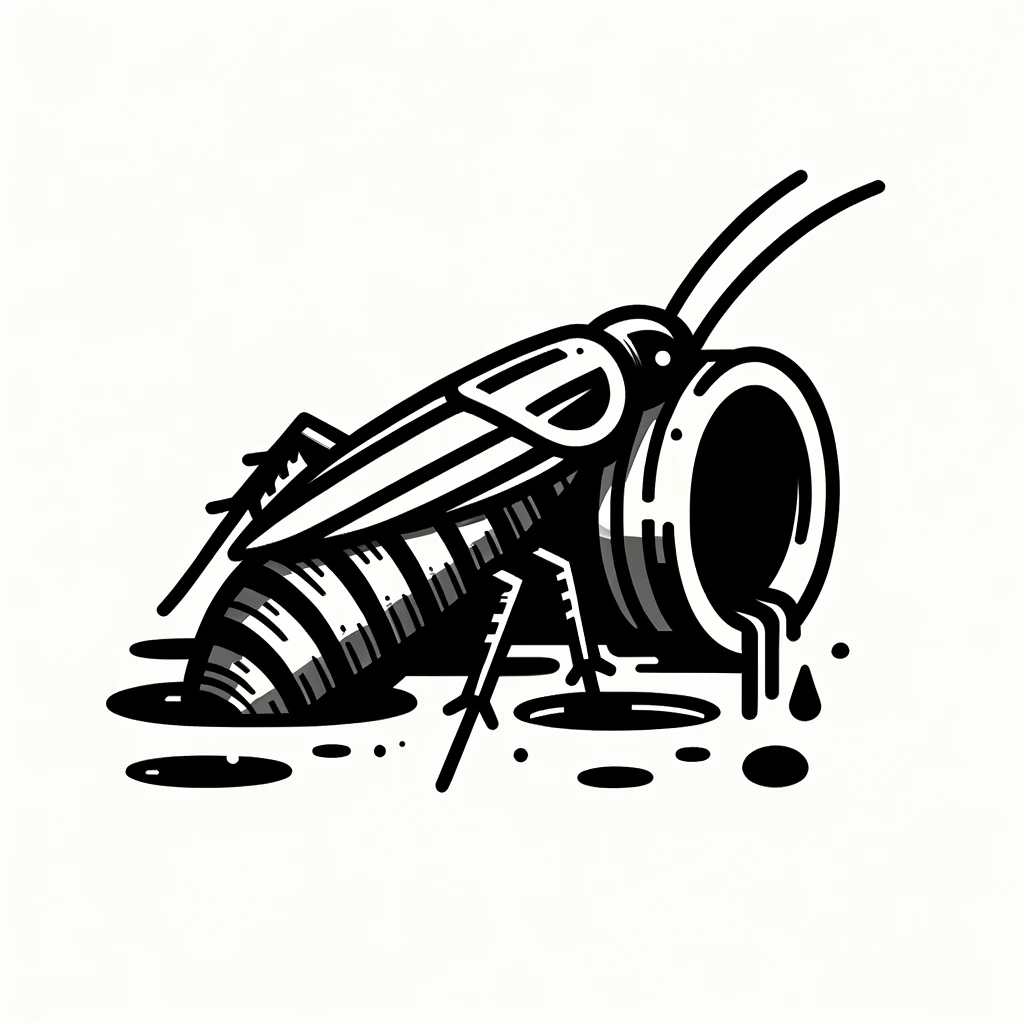 Sewer roaches, often mistaken for the common American cockroach, have garnered a notorious reputation for their unsettling presence in homes and businesses. These pests, emerging from sewers and drains, pose not just a nuisance but also health risks due to the pathogens they carry. This guide delves into the world of sewer roaches, highlighting the health risks they pose and sharing effective control and prevention methods to safeguard your environment.
Sewer roaches, often mistaken for the common American cockroach, have garnered a notorious reputation for their unsettling presence in homes and businesses. These pests, emerging from sewers and drains, pose not just a nuisance but also health risks due to the pathogens they carry. This guide delves into the world of sewer roaches, highlighting the health risks they pose and sharing effective control and prevention methods to safeguard your environment.
Understanding Sewer Roaches
Sewer roaches, primarily American cockroaches, thrive in warm, damp environments. They are commonly found in sewers and drains, making their way into buildings in search of food and water. Identifying these pests is the first step in addressing an infestation:
- Size and Appearance: Sewer roaches are large, typically around 1.5 inches in length, with a reddish-brown color.
- Habitat: They prefer dark, moist areas and are often seen in bathrooms, kitchens, and basements.
Health Risks of Sewer Roaches
The health risks associated with sewer roaches stem from their habitat. These pests can carry bacteria and viruses from the sewers into homes, contaminating surfaces and food:
- Disease Transmission: Sewer roaches can spread diseases like Salmonella, E. coli, and other pathogens.
- Allergies and Asthma: Their droppings and shed skin can trigger allergic reactions and asthma in sensitive individuals.
Effective Control and Prevention Methods
Eradicating sewer roaches requires a combination of cleanliness, exclusion, and targeted treatments.
Cleanliness and Sanitation
- Eliminate Food Sources: Store food in sealed containers and dispose of garbage regularly.
- Reduce Moisture: Fix leaks and ensure proper ventilation in damp areas to make your home less inviting to sewer roaches.
Exclusion Techniques
- Seal Entry Points: Inspect your home for cracks and gaps, especially around pipes and drains, and seal them to prevent roaches from entering.
- Regular Drain Maintenance: Keep drains clean and use drain covers to deter roaches from climbing up.
Targeted Treatments
- Baits and Traps: Use roach baits and traps to reduce the population.
- Professional Pest Control: For severe infestations, consider hiring a pest control professional who can provide a comprehensive treatment plan.
Conclusion
Sewer roaches are unwelcome guests that can pose significant health risks. By understanding these pests and implementing effective control and prevention strategies, you can protect your home and health from their impact. Remember, consistency in prevention efforts is key to keeping sewer roaches at bay.
Flying Cockroach: Identification and Control
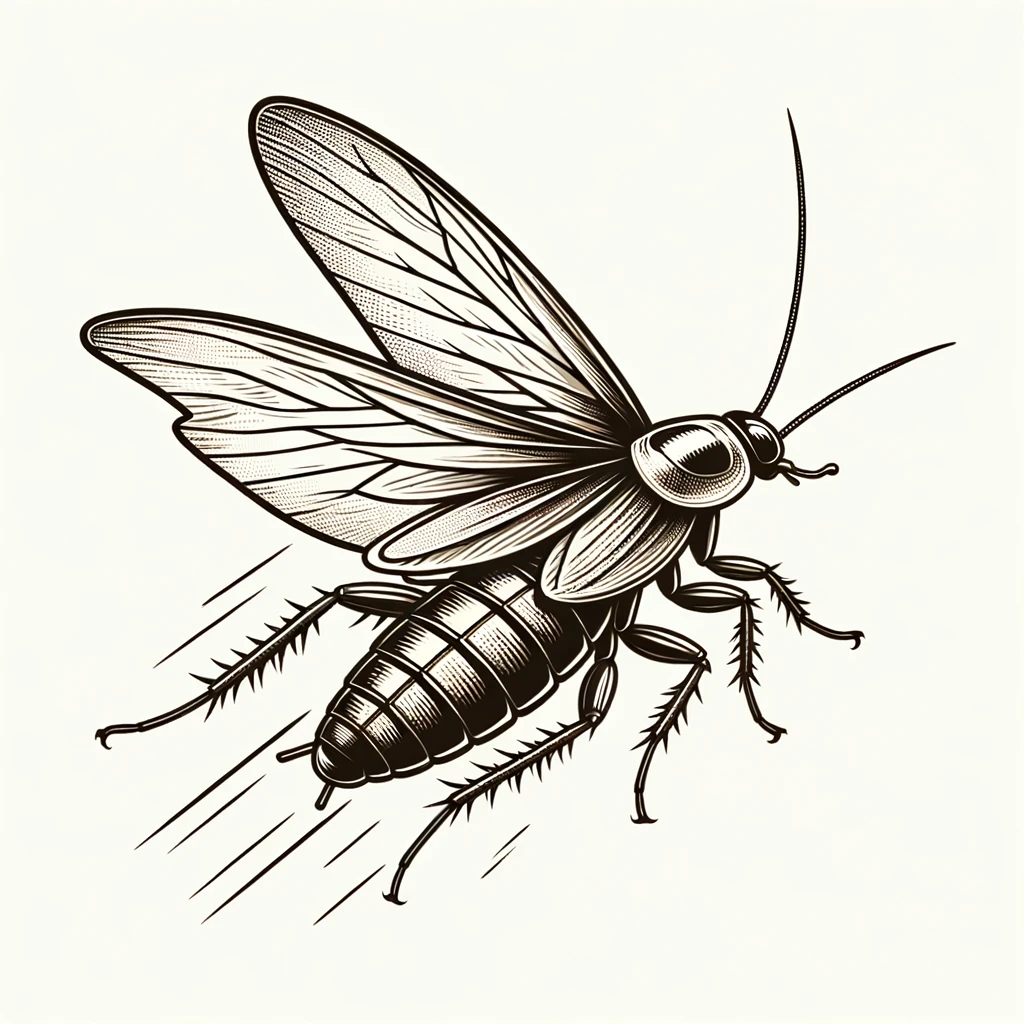 Discovering a flying cockroach in your home can escalate the usual unease associated with these pests to outright alarm. Not only do these airborne invaders indicate a potential infestation, but they also present unique challenges in pest control efforts. This guide is dedicated to demystifying flying cockroaches, offering vital insights into identifying these pests and the most effective strategies to get rid of flying cockroaches in your home.
Discovering a flying cockroach in your home can escalate the usual unease associated with these pests to outright alarm. Not only do these airborne invaders indicate a potential infestation, but they also present unique challenges in pest control efforts. This guide is dedicated to demystifying flying cockroaches, offering vital insights into identifying these pests and the most effective strategies to get rid of flying cockroaches in your home.
Identifying Flying Cockroaches
Common Flying Cockroach Species
- American Cockroach: Known for its alarming size and ability to fly, this species is among the most common flying cockroaches encountered by homeowners.
- Smoky Brown Cockroach: This species thrives outdoors but can venture indoors, flying in search of food and warmth.
- Australian Cockroach: Despite its name, this adept flier is often found far from Australia, easily mistaken for the American cockroach due to similar size and appearance.
Characteristics of Flying Cockroaches
Do cockroaches have wings? Not all do but some cockroaches have wings, some females have longer wings than males.
Flying cockroaches possess a pair of wings longer than their bodies, enabling them to glide from higher to lower surfaces, rather than true powered flight.
Why Do Cockroaches Fly?
Flying cockroaches are not intentionally aggressive towards humans. Their flight is typically triggered by environmental factors such as heat and humidity, as they search for food and suitable habitats.
How to Get Rid of Flying Cockroaches
Maintain Cleanliness
- Eliminate Food Sources: Secure food in sealed containers and promptly clean crumbs and spills to discourage flying cockroaches.
- Reduce Moisture: Address leaky fixtures and employ dehumidifiers to make your home less inviting to these pests.
Seal Entry Points
Regular inspections can reveal potential entry points for flying cockroaches. Sealing these gaps is crucial in preventing access to your home.
Use Targeted Baits and Insecticides
- Baits: Strategically placed cockroach baits can be incredibly effective in reducing flying cockroach populations.
- Insecticides: Select insecticides designed for indoor use against flying cockroaches and apply according to safety instructions.
Professional Pest Control
For stubborn infestations, enlisting professional pest control services can be the most reliable way to get rid of flying cockroaches. Experts can offer targeted treatment plans for your specific situation.
Preventing Flying Cockroach Future Infestations
Consistent preventive measures are key to keeping your home free from flying cockroaches. Regular maintenance and cleanliness can significantly reduce the likelihood of future infestations.
Conclusion
While the presence of flying cockroaches can be particularly distressing, understanding their habits and knowing how to effectively eliminate them can restore peace to your home. Implementing the strategies outlined in this guide will help you identify, control, and prevent flying cockroach infestations.
Cockroach Mouth Parts, Structure, and Functions: A Closer Look
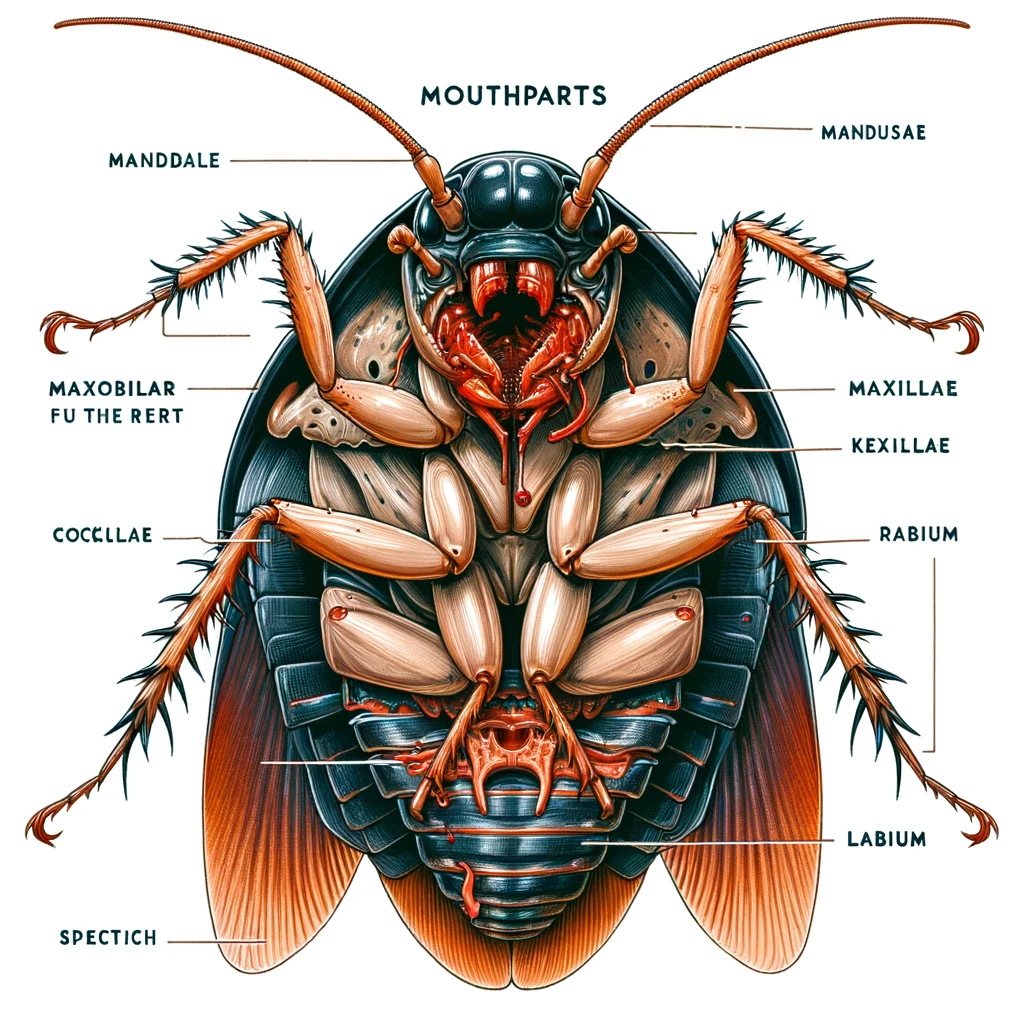 Introduction to Cockroach Anatomy
Introduction to Cockroach Anatomy
Cockroaches are among the most adaptable and resilient creatures on the planet, thriving in a wide range of environments. A key to their survival is their unique anatomy, particularly the structure and function of their mouth parts. Understanding these can provide fascinating insights into how cockroaches feed, interact with their environments, and why they are such successful survivors.
Exploring the Mouth Structure
The Complex Mouthparts of a Cockroach
Cockroaches have a complex set of mouth parts, adapted to their omnivorous diet. Unlike humans, cockroach mouth parts are not located on the front of the head but are directed downwards and backwards, hidden under the head when not in use. This arrangement is known as a hypognathous head.
Components of Cockroach Mouth Parts
- Mandibles: These are the jaws of the cockroach, used for crushing, cutting, and manipulating food. They are powerful and highly adapted to a cockroach’s varied diet.
- Maxillae: Situated behind the mandibles, the maxillae further manipulate and process the food, pushing it towards the back of the mouth.
- Labium: Often referred to as the lower lip, the labium helps hold and manipulate food.
- Labrum: Acting as the upper lip, the labrum assists in directing food into the mouth.
- Hypopharynx: This is a small, tongue-like structure that helps with swallowing.
The Role of Mouth Parts in Feeding
Versatile Diet and Feeding Habits
Cockroaches are known for their versatile diet, feeding on anything from food scraps to fecal matter. The specialized mouth parts allow them to consume solid and liquid food, making them one of the most adaptable pests.
Processing and Digesting Food
Once food is captured and manipulated by the mandibles and maxillae, it’s directed towards the pharynx and down into the digestive system. The efficiency of their mouth parts allows cockroaches to feed on a wide variety of materials, contributing to their ability to survive in harsh conditions.
Conclusion: Masters of Adaptation
The intricate structure and functionality of cockroach mouth parts are a testament to their evolutionary success. These adaptations not only allow cockroaches to feed on an almost limitless range of organic materials but also contribute to their resilience as pests. Understanding the anatomy and feeding habits of cockroaches can provide valuable insights for effective pest management strategies.
American Roaches vs. German Roaches
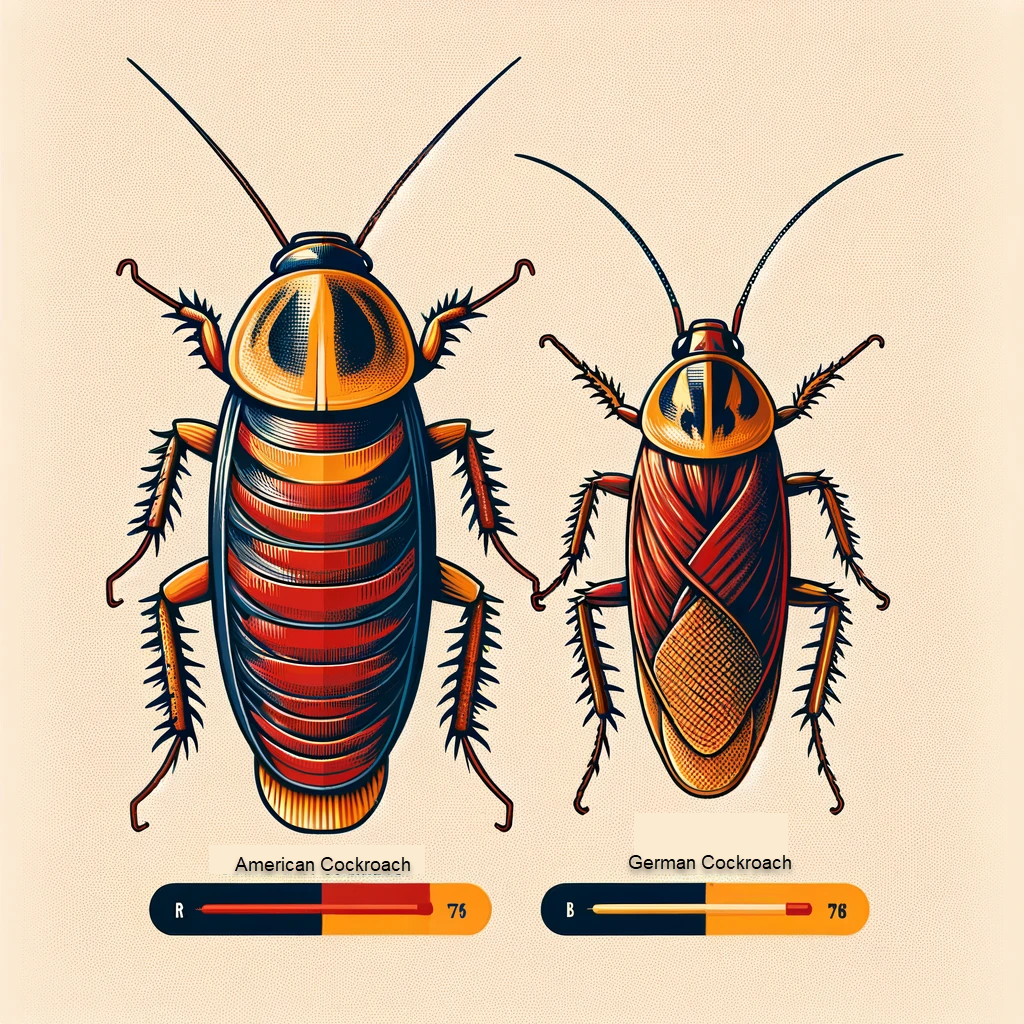 Identifying and Controlling Your Pest Problem
Identifying and Controlling Your Pest Problem
Cockroaches are among the most resilient and unwelcome pests found in homes and businesses worldwide. Among the various species, American and German roaches pose significant challenges due to their adaptability and the health risks they carry. Understanding American Roaches vs. German Roaches differences is crucial for effective identification, control, and prevention. This guide delves into the key distinctions between American Roaches vs. German Roaches, offering insights into their behavior, habitat, and the best strategies for keeping them at bay.
Identifying the Culprits
American Cockroaches
- Size: Among the largest species found in homes, American cockroaches can grow up to 1.5 inches in length.
- Color: Reddish-brown, with a yellowish figure 8 pattern on the back of their heads.
- Habitat: Prefers warm, damp environments such as basements, sewers, and around pipes or drains.
German Cockroaches
- Size: Smaller than their American counterparts, German cockroaches measure about 0.5 inches.
- Color: Light brown to tan, with two dark stripes running from the head to the base of the wings.
- Habitat: Thrives in environments close to food and moisture, making kitchens and bathrooms their favored havens.
Habitat Preferences and Behaviors
While both species are nocturnal and tend to avoid light, their preferred habitats and behaviors offer clues for identification and control:
- American Roaches are more likely to be found in basements and sewers, venturing into homes in search of food.
- German Roaches prefer to live where food and moisture are readily available, often hitchhiking into homes via boxes or bags.
Health Risks and Concerns
Both types of roaches can carry pathogens, contributing to allergies, asthma, and spreading diseases. Their presence can contaminate food sources and kitchen surfaces, emphasizing the need for effective pest control measures.
Effective Control Strategies
Cleanliness and Sanitation
- Reduce food and water sources by fixing leaks, storing food in sealed containers, and maintaining a clean environment.
Exclusion Tactics
- Seal cracks and crevices around doors, windows, and pipes to prevent roaches from entering.
Baits and Traps
- Use species-specific baits and traps to target roaches effectively. German roaches, in particular, may require different bait formulations than American roaches.
Professional Pest Control
- For severe infestations, professional pest control services can provide targeted treatments tailored to the specific roach species present.
Prevention Tips
Preventing future infestations involves maintaining a clean environment, regularly inspecting for signs of roaches, and promptly addressing any potential entry points or attractions.
Conclusion: Knowledge Is Power
Understanding the differences between American and German roaches is the first step toward reclaiming your space from these pests. By identifying the species you’re dealing with, you can implement targeted control strategies and preventive measures to protect your home or business. Remember, persistence and consistency are key in battling these resilient creatures.
- The Life Span of a Cockroach
- Do Cockroaches Eat Clothes?
- Do Cockroaches Have Teeth?
- Shrimps and Cockroaches
- Will Sleeping with the Light On Keep Cockroaches Away?
- How to get roaches out of your car overnight
- Do Cockroaches Feel Pain?
- How Many Legs Do Cockroaches Have?
- Comparing Cockroach Eggs Size for Different Types of Cockroaches
- Identifying a Cockroach Bite on the Lips or Face
- Black Water Bug Identification and Control
- Why Do Water Bugs Come Out At Night?
- What Does Roach Rash Look Like?
- Can Cockroaches Bite Your Eyelid?
- Can Cockroaches Live in Your Balls?
- How did cockroaches get their name?
- Why Do Cockroaches Shed Their Skin?
- What Smell do Palmetto Bugs Hate?
- Baby Palmetto Bug: Identification and Control
- Cockroach Eggs vs Poop: How to Tell the Difference
- How to Get Rid of Water Bugs
- How Long Can a Cockroach Live Without Air?
- The Lifecycle of the German Cockroach: From Egg to Adult
- Do Mice Eat Roaches
- Wood Roach vs. Cockroach